Related Research Articles
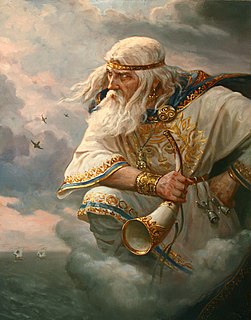
Stribog is the god of Slavic mythology mentioned in three East Slavic sources, whose cult could also exist in Poland. Nowadays he is interpreted as a god of wind who distributes wealth.
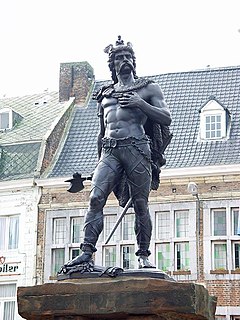
The Eburones, were a Gallic-Germanic tribe, dwelling in the northeast of Gaul, in what is now the southern Netherlands, eastern Belgium, and the German Rhineland, in the period immediately preceding the Roman conquest of the region. Though living in Gaul, they were also described as being both Belgae and Germani.

Rod, in the pre-Christian religion of Eastern and Southern Slavs, is the god of the family, ancestors and fate, perhaps as the supreme god. Among Southern Slavs, he is also known as Sud. He is usually mentioned together with Rozhanitsy deities. One's first haircut (postriziny) was dedicated to him, in a celebration in which he and the rozhanitsy were given a meal and the cut hair. His cult lost its importance through time, and in the ninth or tenth century he was replaced by Perun, Svarog and/or Svetevid, which explains his absence in the pantheon of Vladimir the Great.
Vyraj, Vyriy, or Irij is a mythical place in Slavic mythology where "birds fly for the winter and souls go after death" that is sometimes identified with paradise. Spring is believed to have arrived on Earth from Vyraj.

Khasas were an ancient Bahliki speaking Tribe. They were mentioned in the various historical Indian inscriptions and ancient Indian and Tibetan literatures. They were native Indic peoples who were reported to have lived around Gandhara, Trigarta and Madra Kingdom, gorkha kingdom in the northern Indian subcontinent.
Prof. Dr. Hab. Jerzy Strzelczyk is Polish historian, professor at the Adam Mickiewicz University.
The concept of an otherworld in historical Indo-European religion is reconstructed in comparative mythology. Its name is a calque of orbis alius, a term used by Lucan in his description of the Celtic Otherworld.
The Zeriuani or Zeruiani was an unknown Slavic tribe mentioned by the 9th-century Bavarian Geographer (BG). It states that the Zeruiani "which is so great a realm that from it, as their tradition relates, all the tribes of the Slavs are sprung and trace their origin".
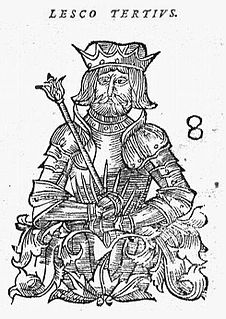
Leszko III was a legendary ruler of Poland, firstly mentioned by Wincenty Kadłubek. Alleged son of Leszko II, father of Popiel I and grandfather of Popiel II.
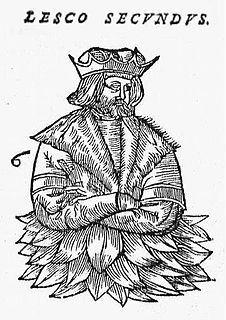
Leszko II was a legendary ruler of Poland, firstly mentioned by Wincenty Kadłubek in the Chronica seu originale regum et principum Poloniae. Alleged progenitor of the Popielids dynasty. Son of Leszko I and father of Leszko III.

Przemysław (Premislaus), after coronation Leszko I, was a legendary ruler of Poland, a goldsmith by trade and soldier who strategically defeated the Hungarians and thus was crowned. He was mentioned by bishop Wincenty Kadłubek (1161–1223) in the Chronica seu originale regum et principum Poloniae (1190–1208). 18th-century historiography dated him to 750 AD, 760–780, or between 750 and 776. James Anderson (1680–1739) claimed he ruled for 20 years.
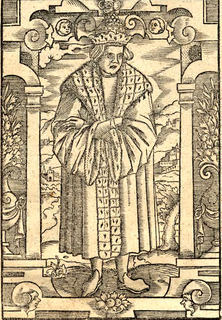
Popiel I was a legendary ruler of Poland, member of the Popielids dynasty. According to the legends reported by Wincenty Kadłubek in his Chronica seu originale regum et principum Poloniae, he was the son of Leszko III. Father of Popiel II.

Krakus II was a ruler of Poland. He was the successor of and son of the alleged founder of the City of Kraków, Krakus I, and he was the younger brother of Lech II, according to Wincenty Kadłubek. He ties the family to the national story of the dragon of Wawel. In this, their father Krak sent them to defeat the dragon, which they managed, after an unsuccessful battle, by stuffing the tribute animals with straw which suffocated the dragon. After this, Krak threw himself upon Lech and killed him, though their father pretended that the dragon was responsible. Eventually the story was found out, and Krak II was overthrown and replaced by his daughter Wanda.
The Sebbirozi was a tribe mentioned by the 9th-century Bavarian Geographer (BG). It states that the Sebbirozi inhabit 90 settlements.
Nav is a phrase used to denote the souls of the dead in Slavic mythology. The singular form is also used as a name for an underworld, over which Veles exercises custody—it is often interpreted as another name for the underground variant of the Vyraj.

Yarovit – god of war worshipped by Polabian Slavs associated with fertility and agriculture. In interpretatio romana compared to Roman god of war Mars. His feast probably fell on April 15 or May 10 - sowing festival. His symbol was a golden shield that was kept in his temple. Because of the identical first part of the name he can be associated with the East Slavic god Yarilo, and because of the semantic similarity with Svetovit, some scholars suggest that both gods are related.

Rozhanitsy, narecnitsy, and sudzhenitsy are invisible spirits or deities of fate in the pre-Christian religion of the Slavs. Related to pregnancy, motherhood, marriage and female ancestors. Often quoted together with Rod. They are usually mentioned three together, but sometimes up to 9 together, of which one was a "queen" or singular. They are related to Dola, but it is not known on what terms. In Poland they were worshipped as zorze (auroras).

Lel and Polel are Polish divine twins, first mentioned by Maciej Miechowita in the 16th century where he presents them as equivalents of Castor and Pollux and the sons of the goddess Łada, the equivalent of Leda. There is no complete agreement about the authenticity of the cult of Lel and Polel.

Niya is a Lechitic god of the underworld of unknown sex, whose exact functions are unknown. Niya is mentioned together with other gods worshipped by Poles, such as Yesha, Łada, or Devana. Niya's cult may be demonstrated by the sayings "Go to Niye" and "Dwell in Nya" collected by Polish ethnographer Aleksander Brückner. In recent years, the confidence in the authenticity of Niya has increased in the scientific community.
Chernoglav or Chernoglov is god of victory and war worshipped in Rügen, probably in the town of Jasmund, mentioned together with Svetovit, Rugievit, Turupit, Puruvit and Pizamar in the Knýtlinga saga.
The fifth god was called Pizamar from a place called Jasmund, and was destroyed by fire, There was also Tjarnaglófi, their god of victory who went with them on military campaigns. He had a moustache of silver and resisted longer than the others but they managed to get him there years later. Altogether, they christened five thousand on this expedition.
References
- ↑ Vadim Makarenko (2003). Откуда пошла Русь?: новая география древнего мира. Вече. ISBN 978-5-9533-0117-6.
- ↑ Witold Chrzanowski (2008). Kronika Słowian: Polanie. Libron. ISBN 978-83-7396-749-6.
- ↑ Rozpravy Československé akademie věd: Řada společenských věd. Academia. 1956.
- ↑ Władysław Kowalenko (1970). Słownik starożytności słowiańskich: encyklopedyczny zarys kultury Słowian od czasów najdawniejszych. Zakład Narodowy im. Ossolińskich. ISBN 978-83-04-00080-3.